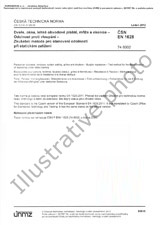We need your consent to use the individual data so that you can see information about your interests, among other things. Click "OK" to give your consent.
ČSN EN ISO 23702-1 (793870)
Leather - Per- and polyfluoroalkyl substances - Part 1: Determination of non-volatile compounds by extraction method using liquid chromatography
Translate name
STANDARD published on 1.12.2023
The information about the standard:
Designation standards: ČSN EN ISO 23702-1
Classification mark: 793870
Catalog number: 518012
Publication date standards: 1.12.2023
SKU: NS-1159553
The number of pages: 40
Approximate weight : 120 g (0.26 lbs)
Country: Czech technical standard
Category: Technical standards ČSN
The category - similar standards:
Annotation of standard text ČSN EN ISO 23702-1 (793870):
This document specifies a test method for detection and quantification of extractable non-volatile per- and polyfluoroalkyl substances (PFAS) in leather and coated leather by solvent extraction and liquid chromatography coupled with mass spectrometry.
This document, taking into account the three-dimensional distribution of the fibres within leather, makes the evaluation of the PFAS with respect to the mass.
PFAS substances categories and applications are listed in Annex A, Table A.1. Classes of PFAS regulated compounds listed in Annex B, Table B.1, include acids, telomers, sulfonates and sulphonamide alcohols. Classes of other non-regulated compounds that can be determined by this document are listed in Annex C, Table C.1
Preview of the standard ČSN EN ISO 23702-1 (793870)
We recommend:
Technical standards updating
Do you want to make sure you use only the valid technical standards?
We can offer you a solution which will provide you a monthly overview concerning the updating of standards which you use.
Would you like to know more? Look at this page.




 Cookies
Cookies
